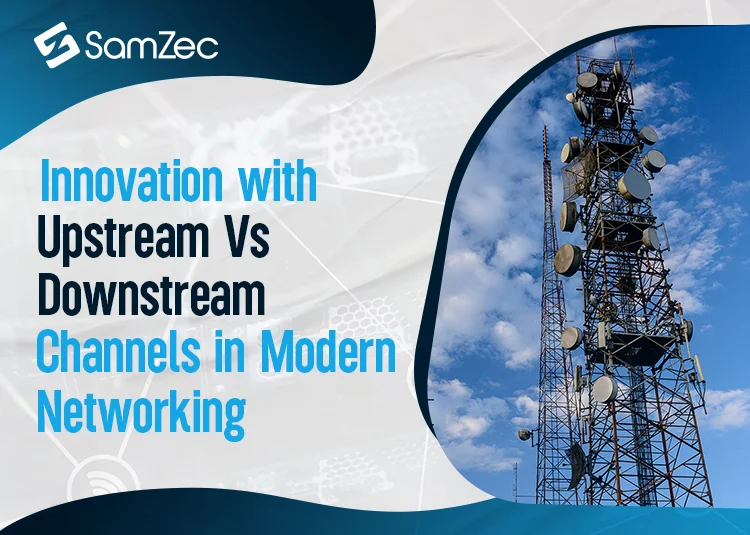The Internet is the most usable source in the world, with the passage of time as technology advances also generating gaps to be filled out with the latest technological equipment.
Now, can you get internet access without a modem? It’s not a tricky question to answer as the modem is the primary source of the internet. Now as of the internet, there are some issues you might be facing.
You might be having trouble with your upstream on your modem. There are some steps through which you can fix your modem upstream issue.
This blog post is about the main discussion of “how to fix upstream on a modem”, upstream problems, and how you can fix them.
Moreover, I will also provide you with tips on how to troubleshoot and diagnose these problems by yourself.
To know in detail keep reading the blog for a better understanding. Before starting the guide, let us know about upstream and downstream.
What is Upstream Channel?
In the context of telecommunications and data transmission, the term “upstream channel” refers to the path through which data is transmitted from an end user or subscriber to a service provider or central hub. It is also known as the “uplink” or “upload” channel.
In a typical communication system, data flows in both directions: downstream, which refers to data transmitted from the service provider or central hub to the end user, and upstream, which refers to data transmitted from the end user to the service provider or central hub.
The upstream connection is responsible for carrying user-generated data, such as requests for information, commands, or user-generated content, from the end user to the service provider or central hub.
The upstream channel is an important component of many communication systems, including broadband internet access, cable television, and other data transmission networks.
It allows ending users to send data back to the service provider or central hub, enabling two-way communication and interaction between the end user and the service provider.
What is Downstream?
It is the opposite of the upstream channel and refers to the “download speed” of the data that your computer receives from the internet. In simple words, the maximum output received by your system.
While you are downloading something with the help of your internet connection that may include movies, songs, podcasts, apps, games, videos, or images. You are using your computer’s downstream bandwidth.
Just like upstream bandwidth, your cable modem speed evaluates the quantity of data (Bandwidth) your computer can receive through the internet at maximum speed.
The downstream channel is responsible for carrying data such as web pages, videos, audio files, and other content from the service provider or central hub to the end user.
It is an important component of many communication systems, including broadband internet access, cable television, and other data transmission networks.
It allows service providers to deliver content to end users efficiently and reliably, enabling them to consume and interact with a wide range of digital media.
What is Upstream Value?
In the context of networking and data communications, the term “upstream value” generally refers to a specific parameter or measurement associated with the upstream channel in a communication system.
The upstream channel is the path through which data is transmitted from the end user or subscriber to the service provider or central hub.
The upstream value could refer to various parameters depending on the specific system or technology being discussed. For example:
Upstream Bandwidth
It could refer to the amount of bandwidth allocated for data transmission from the end user to the service provider or central hub.
This is typically measured in units such as kilobits per second (kbps), megabits per second (Mbps), or gigabits per second (Gbps), and determines the maximum data rate that can be transmitted on the upstream channel.
Upstream Signal Level
It could refer to the strength or power level of the upstream signal as it is transmitted from the end user to the service provider or central hub.
This is typically measured in units such as dBmV (decibels millivolts) or dBm (decibels milliwatts) and is used to indicate the quality and strength of the upstream signal.
Upstream Signal-to-Noise Ratio (SNR)
It could refer to the ratio of the signal strength to the background noise level in the upstream channel.
A higher upstream SNR typically indicates a better quality signal with less noise interference, while a lower SNR may indicate potential signal degradation or issues.
Upstream Modulation Scheme
It could refer to the modulation scheme used for data transmission on the upstream channel. Modulation is the process of converting digital data into analog signals for transmission over a communication channel.
Different modulation schemes, such as QPSK (Quadrature Phase Shift Keying), 8PSK (8 Phase Shift Keying), or 16QAM (16 Quadrature Amplitude Modulation), may be used in the upstream channel, and the specific modulation scheme used can impact the upstream data rate and performance.
Upstream Error Rate
It could refer to the rate of errors or data packet loss that occurs in the upstream channel during data transmission.
A lower upstream error rate typically indicates better data transmission quality, while a higher error rate may indicate potential issues or degradation in the upstream channel.
The specific definition or meaning of “upstream value” may vary depending on the context and the communication system or technology being discussed.
It’s important to consider the specific parameters or measurements associated with the upstream channel in that particular context to understand the meaning of “upstream value” accurately.
Upstream Channel Vs Downstream Channel
The upstream channel and downstream channel are two different directions of data transmission in a communication system. The main differences between them are as follows:
Data Flow Direction
The upstream channel refers to the path through which data is transmitted from the end user or subscriber to the service provider or central hub.
It is responsible for carrying user-generated data, such as requests for information, commands, or user-generated content.
On the other hand, the downstream channel refers to the path through which data is transmitted from the service provider or central hub to the end user.
It is also responsible for carrying data such as web pages, videos, audio files, and other content from the service provider to the end user.
Bandwidth Allocation
In many communication systems, the upstream channel and downstream channel may have different bandwidth allocations.
For example, in some broadband internet access technologies, the downstream channel may have a higher bandwidth allocation compared to the upstream channel.
Furthermore, most end users typically consume more data (e.g., streaming videos, downloading files) than they upload (e.g., sending requests, uploading files), so more bandwidth is allocated to the downstream channel to accommodate the higher data demand.
Data Traffic Characteristics
The upstream channel and downstream channel may have different data traffic characteristics. For instance, the upstream channel typically consists of user-generated data, which can vary greatly in terms of volume, type, and timing.
In contrast, the downstream channel usually carries content that is delivered in a more predictable and scheduled manner, such as web pages, videos, and audio files.
Must Read: How to fix upstream on a modem
Application and Usage
The upstream and downstream channels are used for different purposes in various communication systems. For example, in broadband internet access, the upstream channel is used for user requests, such as sending emails, making online requests, or uploading files.
The downstream channel is used for content delivery, such as streaming videos, downloading files, and browsing web pages.
In cable television systems, the upstream channel may be used for interactive services, such as video on demand (VOD) or interactive gaming, while the downstream channel is used for broadcasting TV channels.
The upstream channel and downstream channel work together to enable two-way communication and data transmission between end users and service providers or central hubs.
Modem Bonded Channels and Speed
The modem has some common configurations according to channels and provides speed according to your upstream and downstream.
Bonded channels can be written as No. of Downstream Channels X No. of Upstream Channels. For example, 8 X 4 means your cable modem has (8) upload channels and (4) download channels.
We can also say that the higher the number of channels, the faster the speed.
The bonded channels include
- 4 X 4
- 8 X 4
- 16 X 4
- 24 X 8
- 32 X 8
It is necessary to have more upstream channels because when you download anything (files, Audio, etc) your client software will have to send recognition packets.
However, this error is not a big issue as it used to be in the time of copper communication cables (telephone).
| 8×4
Cable Modem |
16×4
Cable Modem |
24×8
Cable Modem |
32×8
Cable Modem |
|
| Theoretical DS/US Speeds | 304 Mbit/s / 108 Mbit/s | 608 Mbit/s /108 Mbit/s | 912 Mbit/s / 216 Mbit/s | 1216 Mbit/s / 216 Mbit/s |
| Actual Internet Speed used in real-time | Approx.
100 Mbps |
Approx.
300 Mbps |
Approx.
400 Mbps |
Approx.
500 Mbps |
The above table is a comparison of different bonded channels with respect to speed
The Benefits Of Upstream And Downstream
The upstream channel of a modem, also known as the upstream bandwidth, refers to the portion of the internet connection that allows data to be transmitted from a user’s device to the internet. Here are some benefits of having a strong upstream channel in a modem:
Smooth Data Transmission
A strong upstream channel allows for smooth and efficient data transmission from the user’s device to the internet.
This is particularly important for activities that require uploading data, such as sending emails, uploading files, or participating in online video conferences.
A higher upstream bandwidth can ensure that data is transmitted quickly and without interruptions, resulting in a smoother online experience.
Enhanced User Experience
A robust upstream channel can significantly improve the overall user experience. It reduces the risk of buffering, lag, and delays when uploading data, which can enhance online activities such as video streaming, online gaming, and cloud-based applications.
Users can enjoy a seamless and uninterrupted online experience, without frustrating delays or interruptions.
Support for Multiple Users/Devices
In households or businesses with multiple users or devices connected to the internet simultaneously, a strong upstream channel is essential.
It allows for smooth data transmission from multiple devices uploading data simultaneously, such as when multiple users are streaming, gaming, or uploading files.
This helps to prevent congestion and ensures that all devices can upload data without experiencing delays or interruptions.
Improved Cloud-Based Services
Cloud-based services, such as cloud storage, online backup, and video conferencing, often require uploading data to the internet.
A robust upstream channel can ensure that data is uploaded quickly and reliably to the cloud, improving the performance and effectiveness of these services.
Facilitates Remote Work
In today’s remote work environment, where many people rely on uploading data for video conferences, file sharing, and other work-related activities, a strong upstream channel is crucial.
It enables seamless communication and collaboration, helping remote workers stay productive and efficient.
Benefits of Downstream Channel
The downstream channel of a modem, also known as the downstream bandwidth, refers to the portion of the internet connection that allows data to be received from the internet to a user’s device. Here are some benefits of having a strong downstream channel in a modem:
Fast Internet Speed
A robust downstream channel allows for faster internet speeds, which means that data can be downloaded quickly to the user’s device.
This can result in a faster and more efficient online experience when browsing the web, streaming videos, downloading files, and engaging in other online activities that require data to be downloaded from the internet.
Smooth Streaming and Video Playback
Streaming services, such as online video streaming platforms like Netflix, Hulu, or YouTube, rely on a strong downstream channel for smooth playback of high-quality videos.
A higher downstream bandwidth ensures that video content can be quickly and seamlessly streamed without buffering or interruptions, providing an optimal viewing experience.
Enhanced Gaming Experience
Online gaming often requires large amounts of data to be downloaded from the internet in real-time.
A robust downstream channel can provide lower latency and faster download speeds, resulting in a smoother and more responsive gaming experience, especially for online multiplayer games where low latency is crucial.
Efficient File Downloads
Downloading files from the internet, such as software updates, documents, or multimedia files, can be faster and more efficient with a strong downstream channel.
It allows for quicker downloads, which can save time and improve productivity for tasks that involve downloading large files.
Improved Online Productivity
Many online tasks, such as remote work, online collaboration, and accessing cloud-based applications, rely on the efficient downloading of data from the internet.
A strong downstream channel can ensure that data is received quickly and reliably, leading to improved online productivity and efficiency.
Support for Multiple Users/Devices
In households or businesses with multiple users or devices connected to the internet simultaneously, a strong downstream channel is crucial.
It can provide sufficient bandwidth to support multiple devices downloading data simultaneously without experiencing congestion or reduced performance.
FAQs
How do you read a modem light?
A modem has 4 lights in common which indicate – power, send, receive, and online respectively. Reading a modem light for different sources is very tricky but not impossible.
With a little guidance, you are able to read all the light signal and their meanings.
First check the modem power light is on means your modem is connected to the power source and is working properly.
Send light means your modem is transferring information from your computer to the internet, while receive light is the opposite of the send and indicates the receiving of the information or data files you might be downloading.
Here’s where it gets tough, if all three lights are on on the modem there is no issue as it all shows correctly working, but if only two lights are on then you might be facing a problem with your WiFi.
Why is my modem downstream blinking?
Have you ever figured out and tried to fix your modem malfunction? We all are well aware of the never-ending blinking of the modem.
In addition to modems, the blinking downstream light indicates that you have access to the internet, also the data flow should be better.
Furthermore, sometimes it’s your router that might be creating a mess and need to be fixed, or your IPS needs to deliver a robust connection. Besides this good news for you, most mods come with self-equipped diagnostic tools that can identify the problem and resolve the issues if any.




















